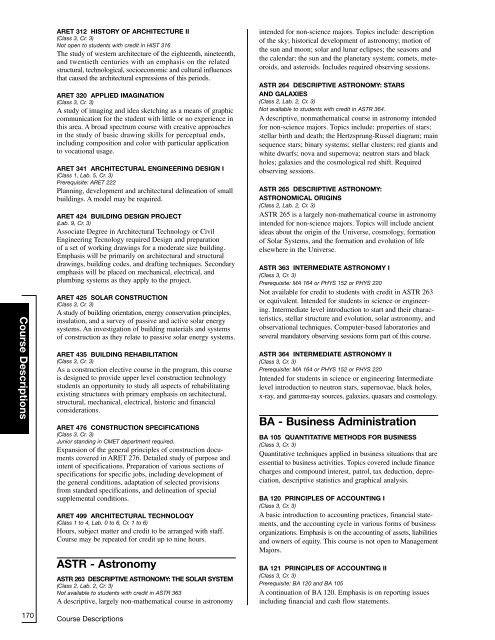ACADEMIC CATALOG - Purdue University Calumet
ACADEMIC CATALOG - Purdue University Calumet
ACADEMIC CATALOG - Purdue University Calumet
Create successful ePaper yourself
Turn your PDF publications into a flip-book with our unique Google optimized e-Paper software.
Course Descriptions<br />
ARET 312 HISTORY OF ARCHITECTURE II<br />
(Class 3, Cr. 3)<br />
Not open to students with credit in HIST 316<br />
The study of western architecture of the eighteenth, nineteenth,<br />
and twentieth centuries with an emphasis on the related<br />
structural, technological, socioeconomic and cultural influences<br />
that caused the architectural expressions of this periods.<br />
ARET 320 APPLIED IMAGINATION<br />
(Class 3, Cr. 3)<br />
A study of imaging and idea sketching as a means of graphic<br />
communication for the student with little or no experience in<br />
this area. A broad spectrum course with creative approaches<br />
in the study of basic drawing skills for perceptual ends,<br />
including composition and color with particular application<br />
to vocational usage.<br />
ARET 341 ARCHITECTURAL ENGINEERING DESIGN I<br />
(Class 1, Lab. 5, Cr. 3)<br />
Prerequisite: ARET 222<br />
Planning, development and architectural delineation of small<br />
buildings. A model may be required.<br />
ARET 424 BUILDING DESIGN PROJECT<br />
(Lab. 9, Cr. 3)<br />
Associate Degree in Architectural Technology or Civil<br />
Engineering Tecnology required Design and preparation<br />
of a set of working drawings for a moderate size building.<br />
Emphasis will be primarily on architectural and structural<br />
drawings, building codes, and drafting techniques. Secondary<br />
emphasis will be placed on mechanical, electrical, and<br />
plumbing systems as they apply to the project.<br />
ARET 425 SOLAR CONSTRUCTION<br />
(Class 3, Cr. 3)<br />
A study of building orientation, energy conservation principles,<br />
insulation, and a survey of passive and active solar energy<br />
systems. An investigation of building materials and systems<br />
of construction as they relate to passive solar energy systems.<br />
ARET 435 BUILDING REHABILITATION<br />
(Class 3, Cr. 3)<br />
As a construction elective course in the program, this course<br />
is designed to provide upper level construction technology<br />
students an opportunity to study all aspects of rehabilitating<br />
existing structures with primary emphasis on architectural,<br />
structural, mechanical, electrical, historic and financial<br />
considerations.<br />
ARET 476 CONSTRUCTION SPECIFICATIONS<br />
(Class 3, Cr. 3)<br />
Junior standing in CMET department required.<br />
Expansion of the general principles of construction documents<br />
covered in ARET 276. Detailed study of purpose and<br />
intent of specifications. Preparation of various sections of<br />
specifications for specific jobs, including development of<br />
the general conditions, adaptation of selected provisions<br />
from standard specifications, and delineation of special<br />
supplemental conditions.<br />
ARET 499 ARCHITECTURAL TECHNOLOGY<br />
(Class 1 to 4, Lab. 0 to 6, Cr. 1 to 6)<br />
Hours, subject matter and credit to be arranged with staff.<br />
Course may be repeated for credit up to nine hours.<br />
ASTR - Astronomy<br />
ASTR 263 DESCRIPTIVE ASTRONOMY: THE SOLAR SYSTEM<br />
(Class 2, Lab. 2, Cr. 3)<br />
Not available to students with credit in ASTR 363<br />
A descriptive, largely non-mathematical course in astronomy<br />
intended for non-science majors. Topics include: description<br />
of the sky; historical development of astronomy; motion of<br />
the sun and moon; solar and lunar eclipses; the seasons and<br />
the calendar; the sun and the planetary system; comets, meteoroids,<br />
and asteroids. Includes required observing sessions.<br />
ASTR 264 DESCRIPTIVE ASTRONOMY: STARS<br />
AND GALAXIES<br />
(Class 2, Lab. 2, Cr. 3)<br />
Not available to students with credit in ASTR 364.<br />
A descriptive, nonmathematical course in astronomy intended<br />
for non-science majors. Topics include: properties of stars;<br />
stellar birth and death; the Hertzsprung-Russel diagram; main<br />
sequence stars; binary systems; stellar clusters; red giants and<br />
white dwarfs; nova and supernova; neutron stars and black<br />
holes; galaxies and the cosmological red shift. Required<br />
observing sessions.<br />
ASTR 265 DESCRIPTIVE ASTRONOMY:<br />
ASTRONOMICAL ORIGINS<br />
(Class 2, Lab. 2, Cr. 3)<br />
ASTR 265 is a largely non-mathematical course in astronomy<br />
intended for non-science majors. Topics will include ancient<br />
ideas about the origin of the Universe, cosmology, formation<br />
of Solar Systems, and the formation and evolution of life<br />
elsewhere in the Universe.<br />
ASTR 363 INTERMEDIATE ASTRONOMY I<br />
(Class 3, Cr. 3)<br />
Prerequisite: MA 164 or PHYS 152 or PHYS 220<br />
Not available for credit to students with credit in ASTR 263<br />
or equivalent. Intended for students in science or engineering.<br />
Intermediate level introduction to start and their characteristics,<br />
stellar structure and evolution, solar astronomy, and<br />
observational techniques. Computer-based laboratories and<br />
several mandatory observing sessions form part of this course.<br />
ASTR 364 INTERMEDIATE ASTRONOMY II<br />
(Class 3, Cr. 3)<br />
Prerequisite: MA 164 or PHYS 152 or PHYS 220<br />
Intended for students in science or engineering Intermediate<br />
level introduction to neutron stars, supernovae, black holes,<br />
x-ray, and gamma-ray sources, galaxies, quasars and cosmology.<br />
BA - Business Administration<br />
BA 105 QUANTITATIVE METHODS FOR BUSINESS<br />
(Class 3, Cr. 3)<br />
Quantitative techniques applied in business situations that are<br />
essential to business activities. Topics covered include finance<br />
charges and compound interest, patrol, tax deduction, depreciation,<br />
descriptive statistics and graphical analysis.<br />
BA 120 PRINCIPLES OF ACCOUNTING I<br />
(Class 3, Cr. 3)<br />
A basic introduction to accounting practices, financial statements,<br />
and the accounting cycle in various forms of business<br />
organizations. Emphasis is on the accounting of assets, liabilities<br />
and owners of equity. This course is not open to Management<br />
Majors.<br />
BA 121 PRINCIPLES OF ACCOUNTING II<br />
(Class 3, Cr. 3)<br />
Prerequisite: BA 120 and BA 105<br />
A continuation of BA 120. Emphasis is on reporting issues<br />
including financial and cash flow statements.<br />
170<br />
Course Descriptions

















